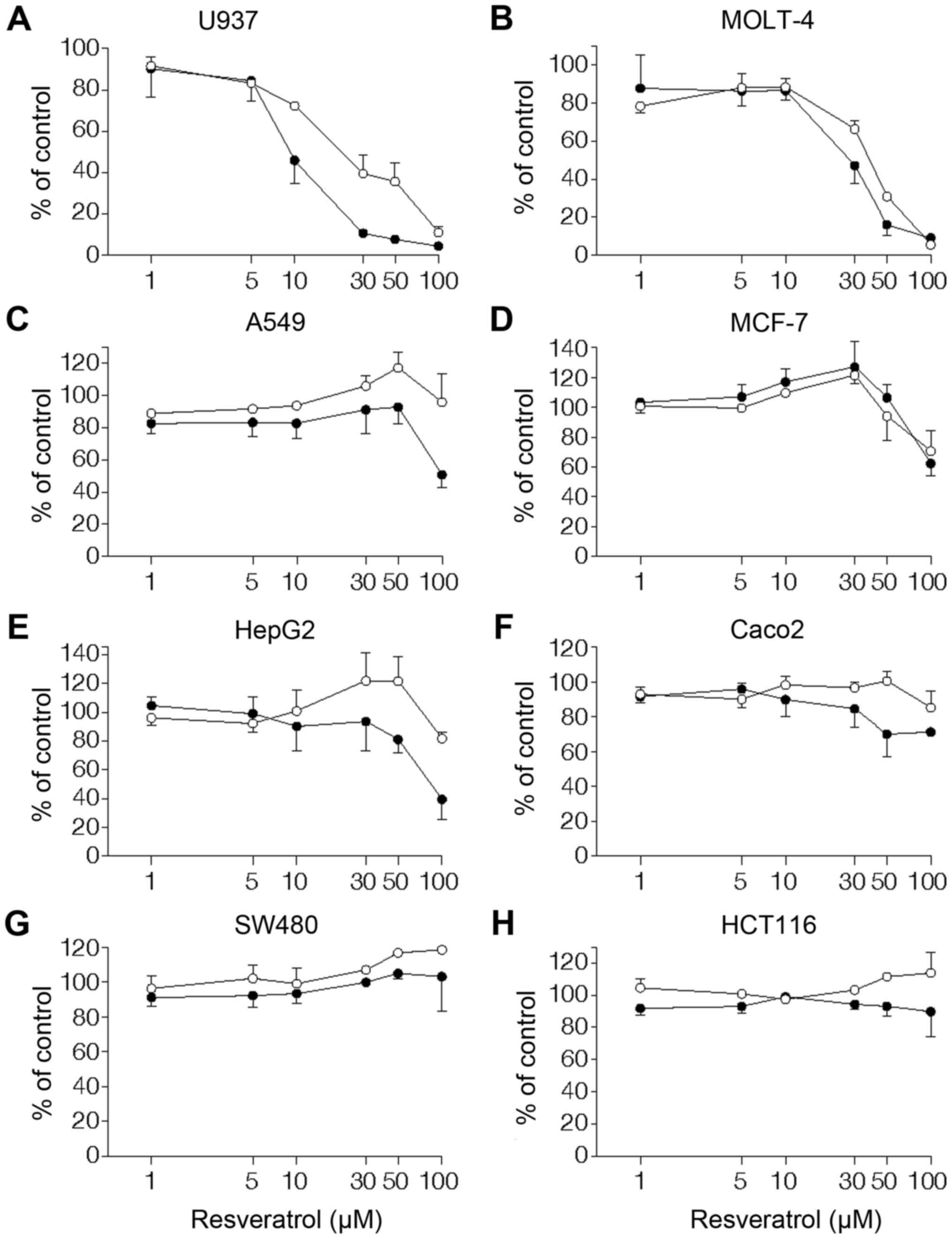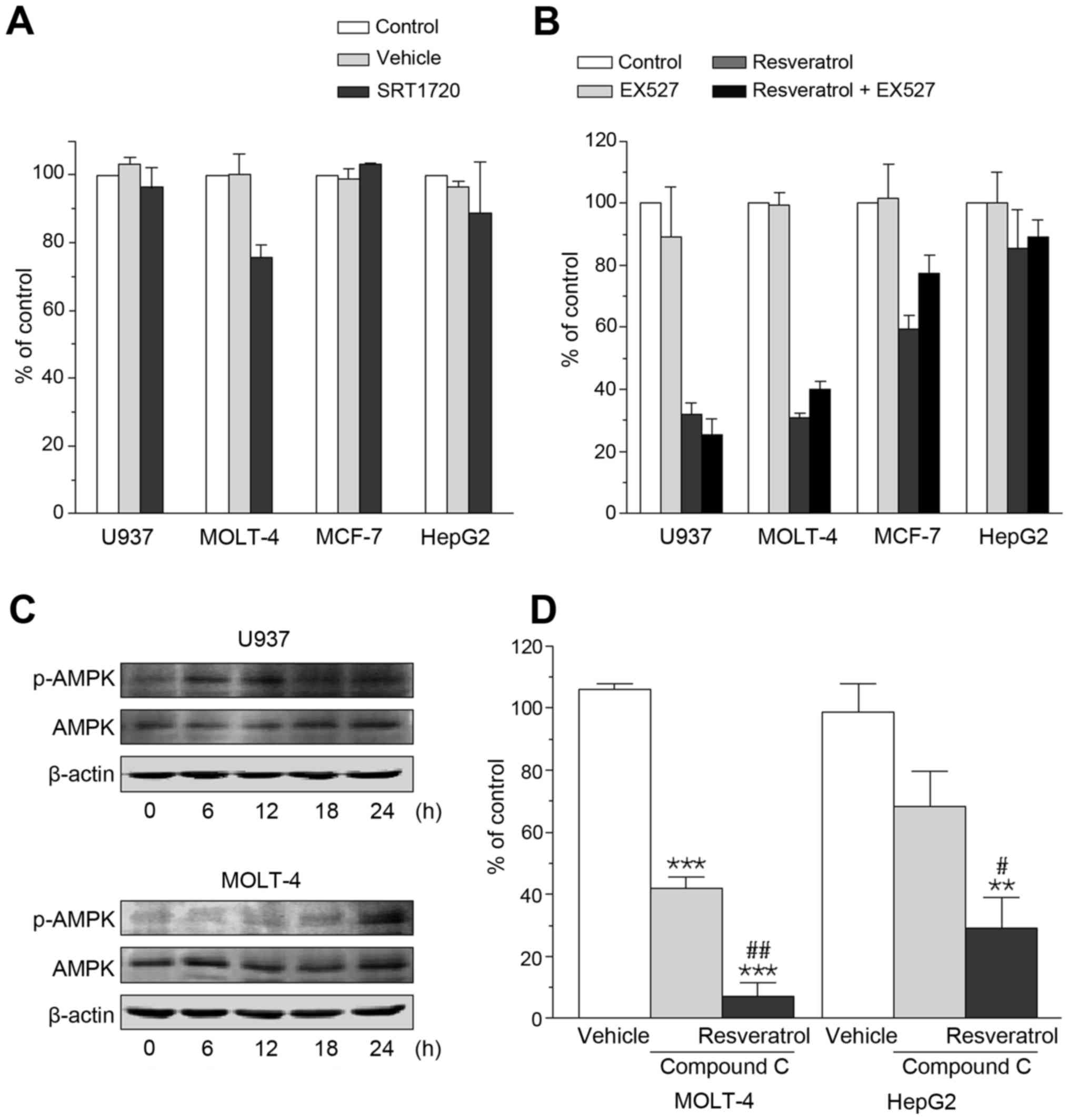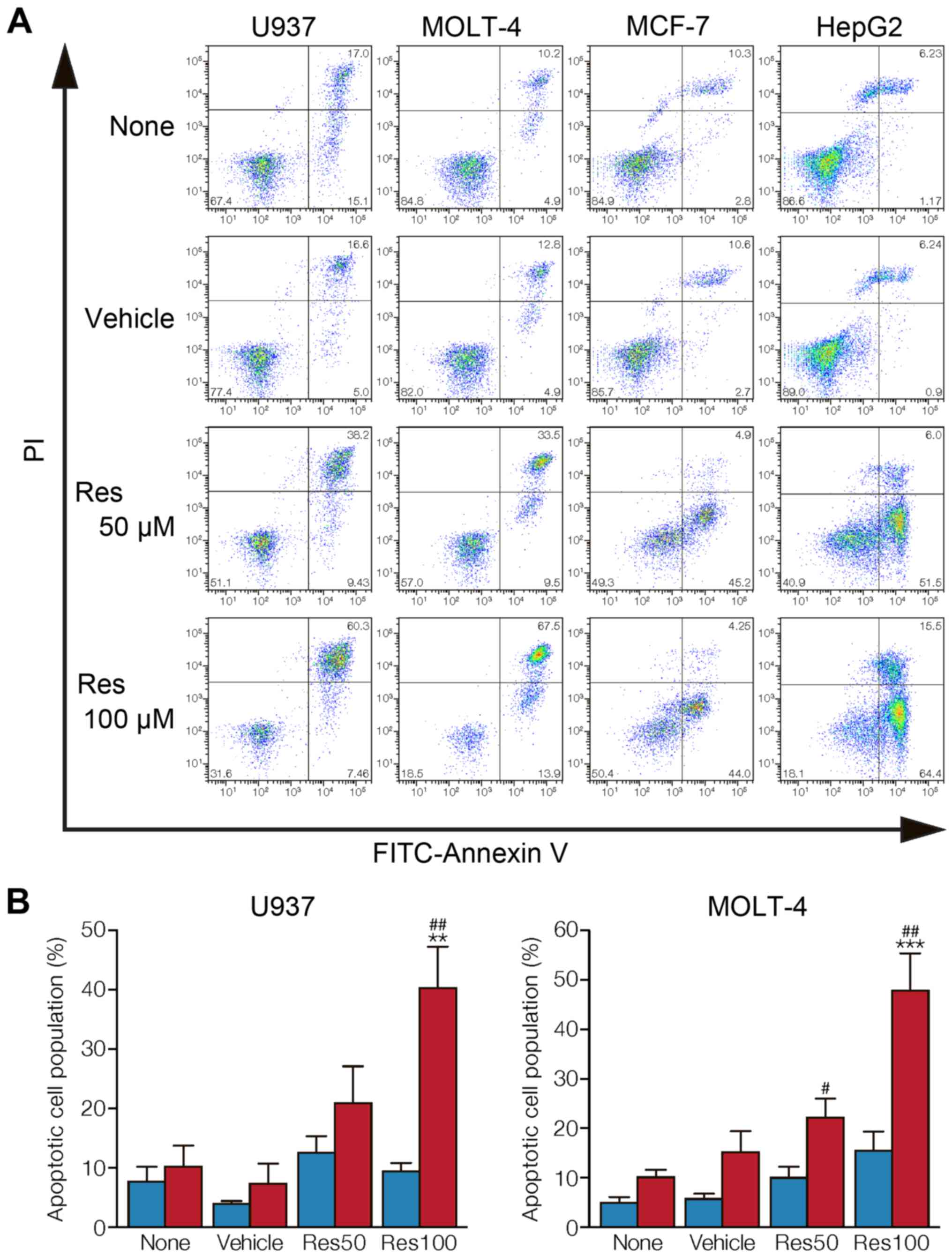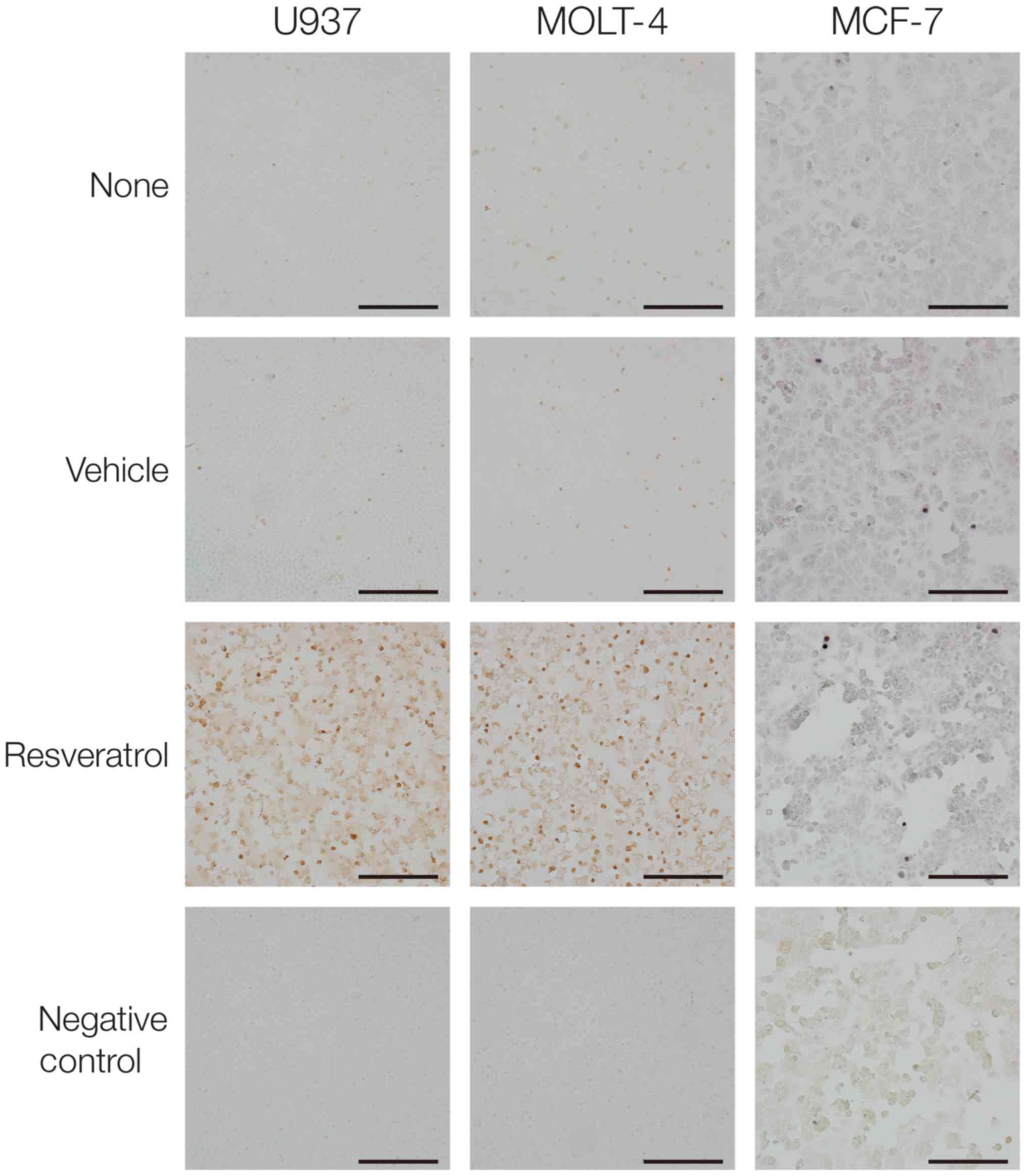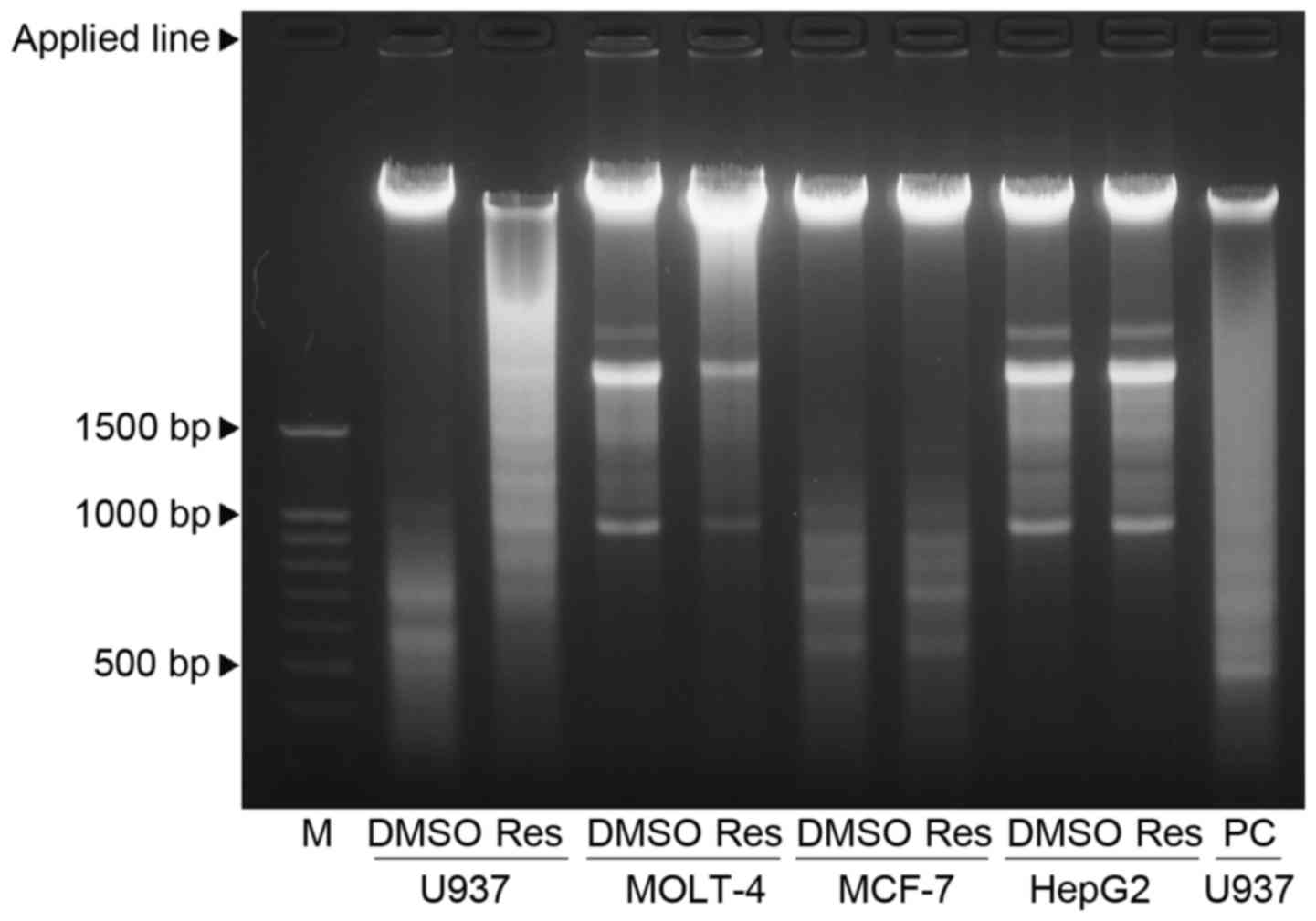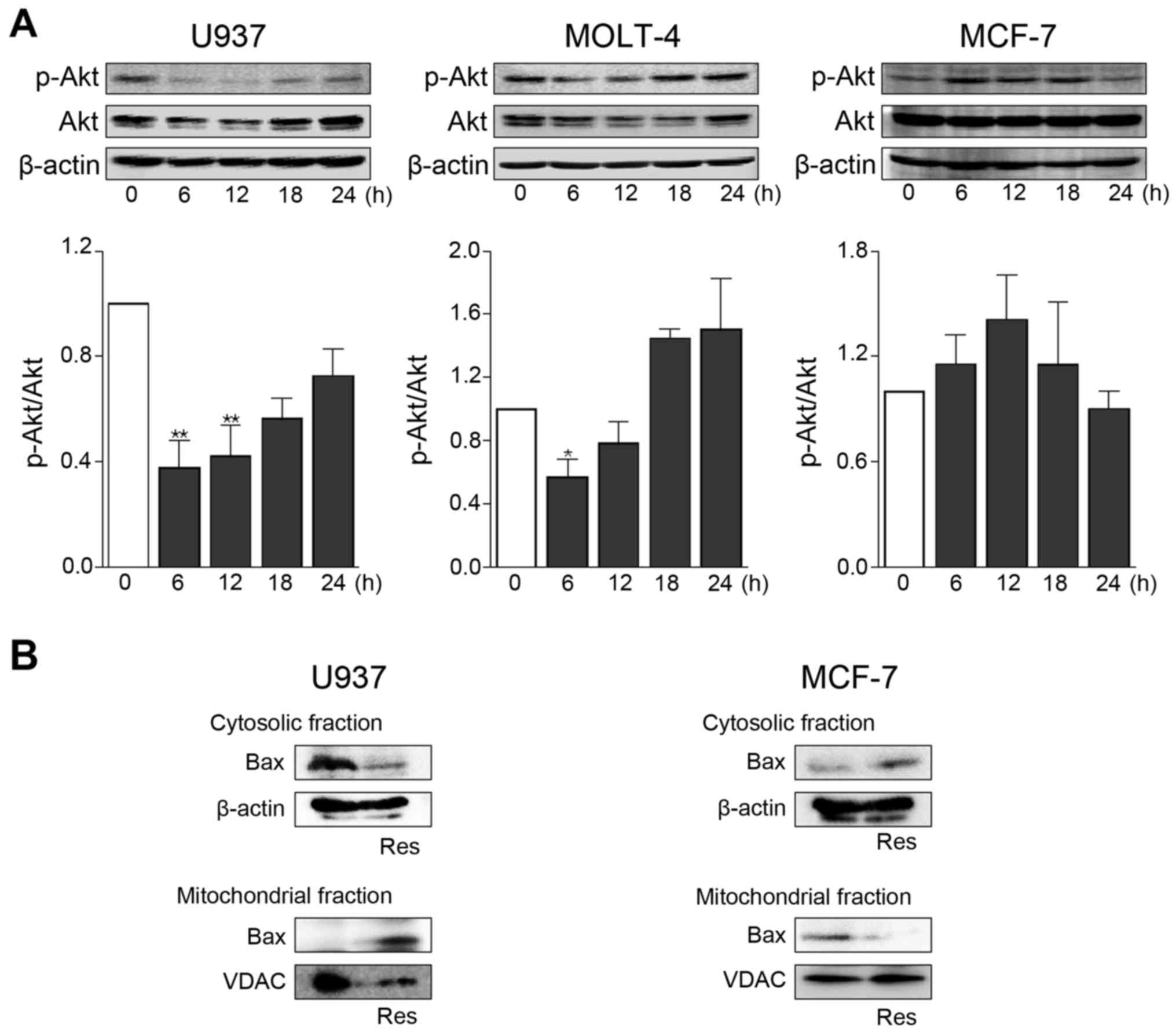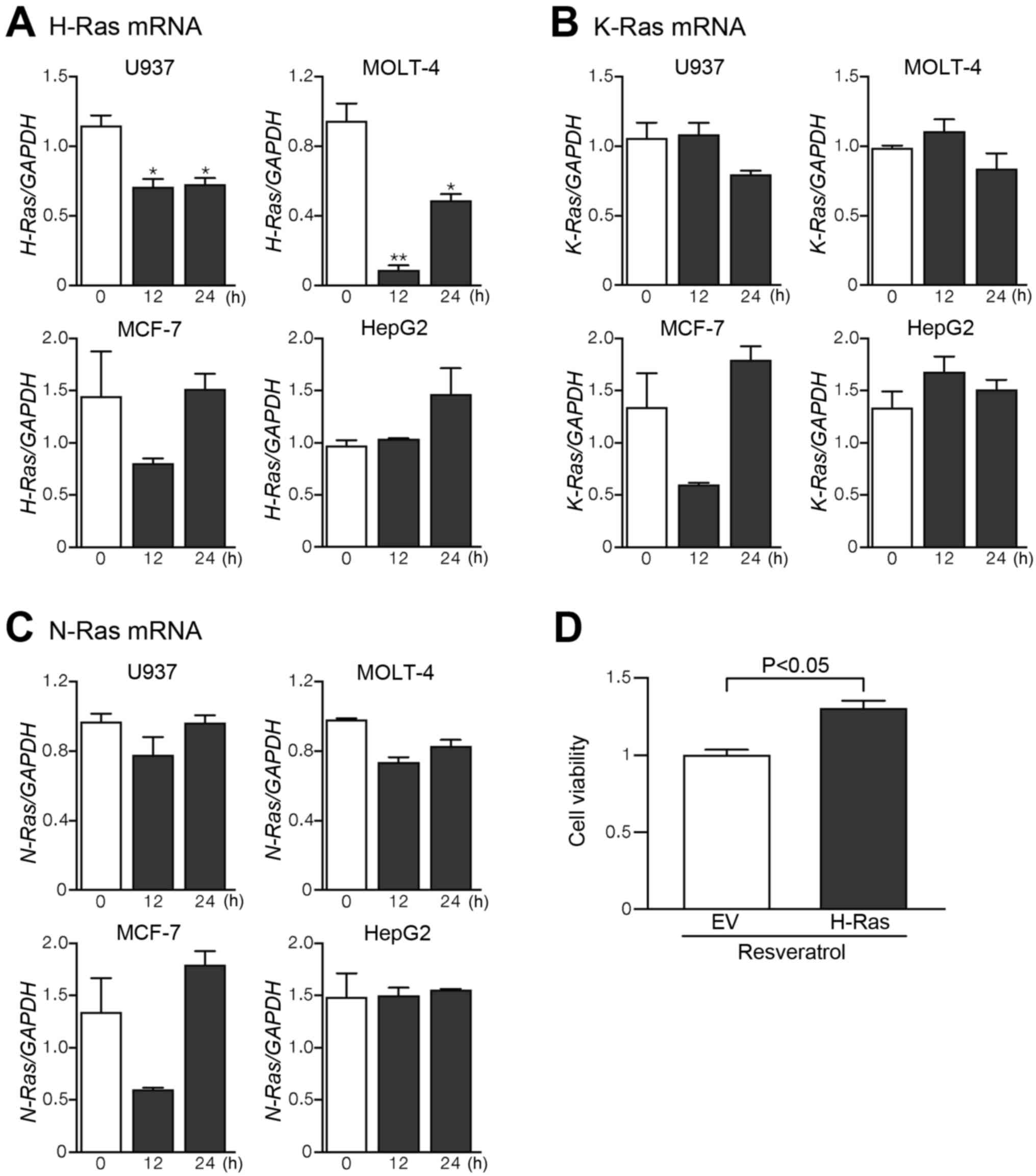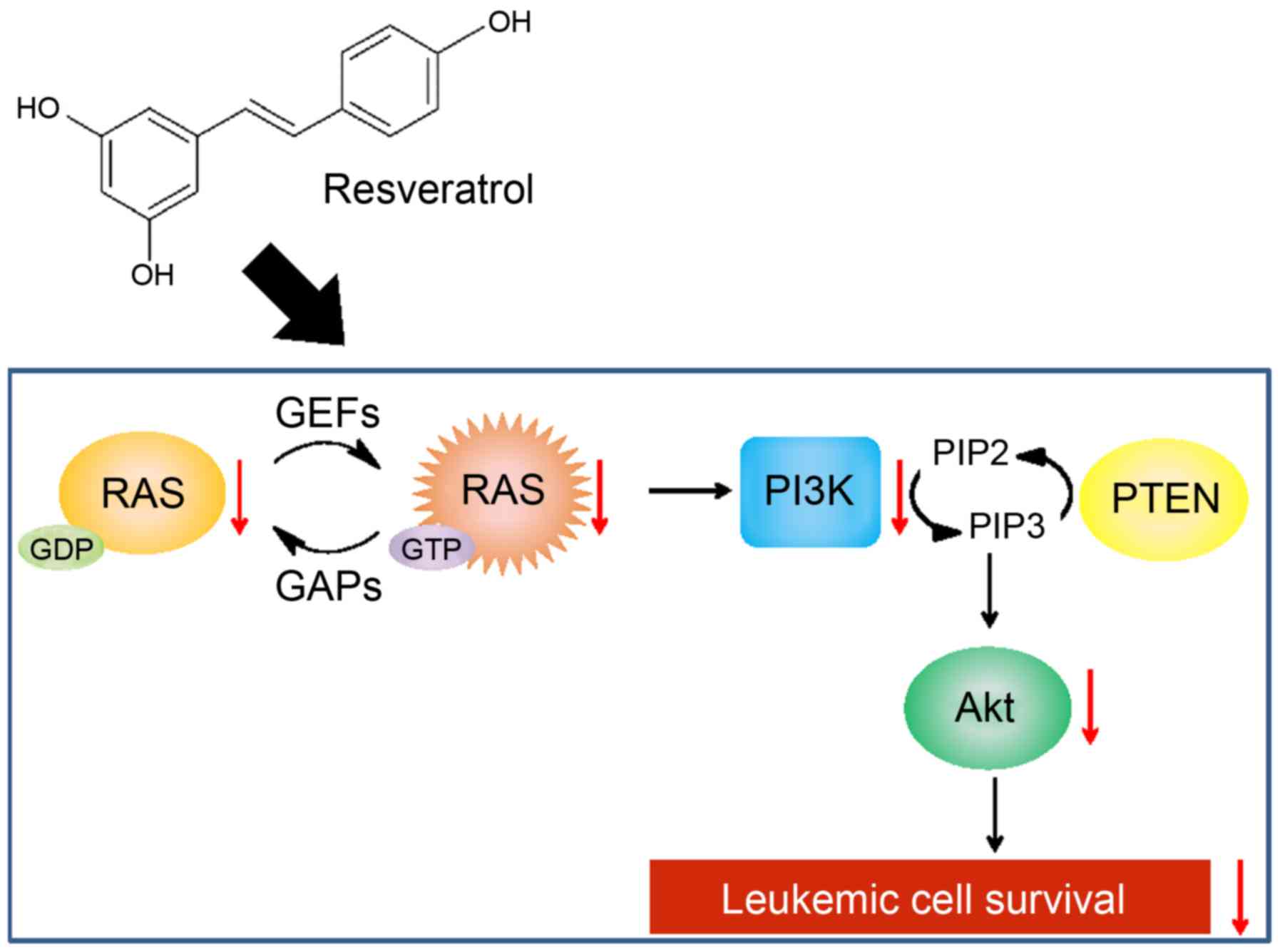Different effect of resveratrol to induction of apoptosis depending on the type of human cancer cells
- Authors:
- Published online on: January 24, 2017 https://doi.org/10.3892/ijo.2017.3859
- Pages: 787-797
Abstract
Introduction
The polyphenolic phytoalexin, resveratrol (3,5,4′-trihydroxy-trans-stilbene), is a naturally occurring phytochemical that is produced by more than 70 plant species and is highly enriched in grape skins, raspberries, mulberries, peanuts, and red wine (1,2). This natural product has been shown to possess many biological activities, including anti-inflammatory, neuroprotective, antiviral, and antifungal properties (3,4). In addition, resveratrol may be a potential anticancer agent in the humans (5,6). Resveratrol is likely to exert anticancer properties by inhibiting three major stages of carcinogenesis, namely tumor initiation, promotion, and progression (2). Dozens of reports have documented that resveratrol can inhibit the proliferation of several kinds of tumors, such as leukemia, pancreas, breast, prostate, bladder, and colon cancers (7–12). However, the molecular mechanisms that contribute to the anticancer activity of resveratrol are not completely understood.
It has been shown that the resveratrol-induced growth inhibition is associated with cell-cycle arrest and induction of apoptotic cell death in cancer cell lines derived from different origins (13–18). Alterations in expression of the anti-apoptotic protein Bcl-2, loss of mitochondrial function, release of cytochrome c, and activation of caspases may be involved in resveratrol-induced apoptotic cell death (19–22). Furthermore, resveratrol has been reported to induce p53-independent apoptosis in human HCT116 colon carcinoma cells (23), although p53 appears to be required for resveratrol-induced apoptosis in other cancer cell lines (24,25). In those previous reports, the concentrations of resveratrol used are varied. Then, it is possible that the signaling cascades for the resveratrol-induced apoptotic cell death are different depending on the types of cancer cells. Resveratrol is also known to act as an antioxidant and to activate adenosine-monophosphate-activated protein kinase (AMPK) and sirtuin 1 (SIRT1) (26), but whether these properties are responsible for the mechanisms through which resveratrol induces cancer cell death has not been fully defined.
In the present study, we examined the effects of resveratrol on cell viability in a variety of human cancer cell lines. We found that they display quite different sensitivity to resveratrol's anti-viability activity, depending on the type of cancer cells. Further studies were then undertaken to focus on the elucidation and analysis of the cell death-initiating signaling mechanisms that can be activated by resveratrol in different cancer cell lines. We also addressed whether several cellular events stimulated with resveratrol, including SIRT1 and AMPK activation, are involved in its anti-viability effect on cancer cells.
Materials and methods
Cell culture
Human leukemic monocyte lymphoma cell line, U937, and human acute T lymphoblastic leukemia cell line, MOLT-4, were obtained from Health Science Research Resources Bank (Osaka, Japan). The two leukemic cell lines were cultured in suspension using RPMI-1640 medium (Nissui Pharmaceutical, Tokyo, Japan) with 10% heat inactivated fetal bovine serum at 37°C in a humidified air with 5% CO2. The human breast cancer cell line MCF-7, and human colorectal cancer cell line SW480, were obtained from American Type Culture Collection (Manassas, VA, USA). The human hepatocellular liver carcinoma cell line HepG2 (RCB1886), human lung adenocarcinoma epithelial cell line A549 (RCB0098), and human colon cancer cell lines Caco-2 (RCB0988) and HCT116 (RCB2979), were provided by the RIKEN BRC through the National Bio-Resource Project of the MEXT, Japan. These solid tumor cell lines were grown in Dulbecco's minimal essential medium (DMEM) (Nacalai Tesque, Kyoto, Japan), supplemented 10% fetal bovine serum, and maintained at 37°C in a humidified atmosphere containing 5% CO2.
Cell viability assay
Cell viability was assessed using the colorimetric MTT (3-(4,5-dimethylthiazol-2-yl)-2,5-diphe-nyltetrazolium bromide) tetrazolium reduction assay (27). Cells were seeded in 96-well plates at 20,000 per well and cultivated for 24–48 h before the onset of treatment with resveratrol, SIRT1720, or their vehicle DMSO. An equal volume of DMSO (≤0.5%, v/v) was used as solvent control, which was confirmed to have little or no effect on cell proliferation. At the end of each treatment time, MTT was added to each well at a final concentration of 0.5 mg/ml, followed by incubation at 37°C for 3 h. The absorbance of each sample was measured with a FilterMax F5 multi-mode microplate reader (Molecular Devices, Sunnyvale, CA, USA) at 595 nm. Cell-free wells containing only medium were used for background subtraction. The number of viable cells was calculated from the number of untreated cells, and the data were expressed as percent cell viability. All experiments were performed at least in triplicate.
Cell death detection using flow cytometry
Cell death was detected by flow cytometry after Annexin V-FITC/propidium iodide (PI) double staining as specified in the protocol provided with the FITC Annexin V Apoptosis Detection kit II (BD Pharmingen, Erembodegen, Belgium). Cells were seeded in 6-well plates, cultivated for 24-48 h, and treated with resveratrol or DMSO. Then, cells were washed with PBS, harvested by trypsinization, centrifuged, and resuspended in binding buffer from the kit containing Annexin V-FITC and PI. The samples were analyzed using a flow cytometer (FACSCanto II, Becton-Dickinson, Franklin Lakes, NJ, USA), as reported earlier (28).
TUNEL staining
The terminal deoxynucleotide transferase-mediated dUTP nick end labeling (TUNEL) technique was conducted to detect apoptotic cancer cells. Cytospin preparations of cancer cells were stained with Takara In Situ Apoptosis Detection kit (Takara Bio, Ohtsu, Japan) according to the manufacturer's instructions. Briefly, cells were fixed with 10 N mildform solution (Wako Pure Chemical, Osaka, Japan) for 30 min at room temperature. Subsequently, cells were incubated with terminal deoxynucleotidyl transferase (TdT) enzyme and anti-fluorescein isothiocyanate-horseradish peroxidase. Labeled DNA was visualized by chromogenic staining with 3′3-diaminobenzidine. Counterstaining was performed with methyl green.
DNA agarose gel electrophoresis
Genomic DNA was isolated from cancer cells by the standard method. After precipitation by ethanol, DNA was dissolved in TE buffer (pH 8.0). DNA (500 ng) was pipetted onto a 1% agarose gel containing 100 ng/ml ethidium bromide, and electrophoresis was performed.
Western blot analysis
Cells were harvested and lysed in 300 µl of RIPA buffer (25 mM Tris-HCl, 150 mM NaCl, 1% NP-40, 1% sodium deoxycholate, 0.1% SDS, pH 7.4; Thermo Fisher Scientific, Rockford, IL, USA) containing protease inhibitor cocktail on ice. The lysates were centrifuged at 18,000 × g for 10 min at 4°C and the resulting supernatants were collected. The proteins in the supernatant were measured using BCA Protein assay kit (Thermo Fisher Scientific). When required, the membrane fractions were prepared as described previously (29). Mitochondrial and cytosolic fractionation was performed using K-assay® Cytochrome c Releasing Apoptosis assay (Kamiya Biochemical Co., Seattle, WA, USA). Immunoblotting was performed as described in our previous reports (29,30). Samples (30–100 µg of protein) were run on 10–16% SDS-polyacrylamide gel and electrotransferred to polyvinylidine difluoride filter membrane. The membrane was blocked for 60 min at room temperature in Odyssey blocking buffer, followed by overnight incubation with primary antibody at 4°C. Primary antibody detection was performed with horseradish peroxidase-conjugated or IRDye®-labeled secondary antibodies. Binding of the antibody was detected by an ECL Plus chemiluminescent system (GE Healthcare, Tokyo, Japan) and levels of protein expression were quantitated by a luminoimage LAS-3000 analyzer (Fuji Film, Tokyo, Japan). Fluorescent of IR-Dye was analyzed by Odyssey CLx Infrared Imaging System (LI-COR Bioscience, Lincoln, NE, USA).
The following antibodies, which are commercially available, were used: anti-human AMPK rabbit polyclonal antibody (Cell Signaling, Danvers, MA, USA), anti-human phospho-AMPK (Thr-172) rabbit polyclonal antibody (Cell Signaling), anti-mouse Akt (pan) rabbit monoclonal antibody (Cell Signaling), anti-human phospho-Akt (Ser-473) rabbit monoclonal antibody (Cell Signaling), and anti-human Bax rabbit polyclonal antibody (Santa Cruz Biotechnology, Santa Cruz, CA, USA). Anti-human β-actin rabbit polyclonal antibody (Bioss, Woburn, MA, USA) was used as a loading control. Anti-human VDAC mouse monoclonal antibody (Cell Signaling) was used as a marker of the mitochondrial outer membrane.
RNA extraction and quantitative real-time PCR
Total RNA was isolated from cells with Sepazol-RNA I Super G (Nacalai Tesque). ReverTra Ace qPCR RT Master Mix (Toyobo, Osaka, Japan) was used for the reverse transcription reaction, and real-time PCR analyses were performed using SYBR Premix Ex Taq (Tli RNaseH Plus), ROX plus (Takara Bio). Values were normalized to glyceraldehyde-3-phosphate dehydrogenase (GAPDH) according to the manufacturer's protocol (MX3000P real-time PCR system; Agilent Technologies Inc., Santa Clara, CA, USA).
Transient transfection of H-Ras in U937
An expression plasmid encoding the human H-Ras, pcDNA3-H-Ras_wt (#39503), was purchased from Addgene (Cambridge, MA, USA). Transfection into the cells was performed using HVJ Envelope Vector Kit GenomONE (Ishihara Sangyo, Osaka, Japan) according to the manufacture's instructions. Briefly, 80 µg of plasmid DNA was encapsulated into HVJ-Es vector and added to 2×106 of U937 cells. The cells were centrifuged (2000 g) at 4°C for 10 min. The efficacy of the transfection was evaluated by qPCR analysis. This approach led to successful overexpression (>60-fold) of the H-Ras gene.
Statistical analysis
Using GraphPad Prism® version 6.0 software (San Diego, CA, USA), statistical analysis was performed and graphs were drawn. Mean values and standard error of mean were calculated and all values are expressed as means ± SEM. Comparisons of more than three data were determined by one-way ANOVA followed by the Tukey's multiple comparison test. Student's t-test was used when two means were compared. The level of statistical significance was set at P<0.05.
Results
Effects of resveratrol on cell viability in a variety of cancer cell lines
Cell viability was examined by MTT assay following treatment with different concentrations (1–100 µM) of resveratrol for 24 and 48 h in a variety of human cancer cell lines. In leukemic monocyte lymphoma U937, resveratrol inhibited cell viability in a concentration- and time-dependent manner, with 10 µM being the lowest effective concentration (Fig. 1A). Similarly, a great inhibition by resveratrol of cell viability was observed in the leukemic cell line MOLT-4 (Fig. 1B). As for U937 and MOLT-4, treatment with 100 µM resveratrol for 24 h resulted in a 90±4% (n=3) and 82±9% (n=3) decrease in cell viability, respectively. Resveratrol also affected cell viability in MCF-7 breast cancer cells (Fig. 1C) and HepG2 liver cancer cells (Fig. 1D). However, the anti-viability effect of resveratrol on MCF-7 and HepG2 was less pronounced than that on human leukemic cells. In the A549 lung cancer cell line, a significant inhibition of cell viability (51±14%, n=3) was detected only by long-term treatment with resveratrol at a high concentration (100 µM, 48 h) (Fig. 1E). When the cytocidality of resveratrol was assessed using colorectal carcinoma cell lines, Caco-2, HCT116, and SW480, these cancer cells were resistant to resveratrol. Thus, resveratrol showed only a marginal anti-viability effect on Caco-2 (Fig. 1F) and was without effect on viability of HCT116 and SW480 (Fig. 1G and H).
The benefits of resveratrol are considered to be derived, in part, from activation of SIRT1 (26), and SRT1720 is a selective activator of SIRT1 that is 1,000-fold more potent than resveratrol (31). In sharp contrast with resveratrol, however, SIRT1720 even at a concentration of 1 µM has no effect on cell viability in U937, MOLT-4, MCF-7, and HepG2 (Fig. 2A). Furthermore, even though these cells were treated with the SIRT1 inhibitor EX527 (1 µM), the anti-viability effect of resveratrol remained unaffected (Fig. 2B).
Resveratrol is also known to activate AMPK (31), and AMPK has been widely shown to be involved in cell death induction in conditions of its sustained activation (32). Increased phosphorylation of AMPK was detectable in U937 at 6 and 12 h and in MOLT-4 at 24 h after treatment with 100 µM resveratrol (Fig. 2C). However, the presence of the AMPK inhibitor compound C (5 µM) failed to negate the anti-viability effect of resveratrol observed in U937, MOLT-4, MCF-7, and HepG2. Fig. 2D shows that compound C by itself caused a decrease in cell viability but a further cell viability reduction was detected when MOLT-4 and HepG2 were treated with resveratrol in the presence of compound C.
Assessment of resveratrol-induced apoptotic cell death
To examine whether cancer cells undergo apoptosis, untreated, vehicle-treated, or resveratrol-treated U937, MOLT-4, MCF-7, and HepG2 were stained with Annexin V and PI. Flow cytometry analysis of stained cells can distinguish cells into four quadrants, viable (Annexin V-negative, PI-negative), early apoptosis (Annexin V-positive, PI-negative), late apoptosis (annexin-positive, PI-positive), and necrotic (Annexin V-negative, PI-positive) cells. When treated with 50 and 100 µM resveratrol for 24 h, the leukemic cells U937 and MOLT-4, showed a significant increase in the population of late apoptotic cells in a concentration-dependent manner (Fig. 3A and B). However, MCF-7 and HepG2 treated with resveratrol for 24 h underwent apoptosis with an increased population of early apoptosis (Fig. 3A).
Resveratrol-induced chromosomal DNA fragmentation
DNA fragmentation represents a characteristic hallmark of late apoptosis. The TUNEL staining was used for the detection of chromosomal DNA fragmentation (Fig. 4). Treatment with 100 µM resveratrol for 24 h led to a marked increase in TUNEL-positive cells in U937 and MOLT-4. In the face of resveratrol treatment, however, the proportion of TUNEL-positive cells was much less in MCF-7 as compared to the two leukemic cells.
DNA fragmentation after resveratrol treatment was also assessed by DNA agarose gels (Fig. 5). Both U937 and MOLT-4 cells treated with 100 µM resveratrol for 24 h displayed a smear pattern of DNA fragmentation, although ladder formation was more pronounced in U937 than in MOLT-4. In contrast, MCF-7 showed a relatively clear band of intact DNA regardless of resveratrol treatment.
Effects of resveratrol on Akt activation and Bax mitochondrial translocation
Activation of the serine/threonine kinase Akt was assessed by western blot analysis for phosphorylated Akt at Ser-473 (Fig. 6A). In U937 and MOLT-4, Akt phosphorylation showed a transient but significant decrease after treatment with 100 µM resveratrol. The total expression level of Akt was constantly unaltered by resveratrol, thus demonstrating that the reduced amount of phosphorylated Akt was not due to decreased expression of Akt. However, Akt phosphorylation levels were substantially unchanged in MCF-7 treated with resveratrol.
Pro-apoptotic protein Bax plays a critical role as an executioner of mitochondrial outer membrane permeabilization during apoptosis (33). Akt kinase can directly prevent Bax translocation to mitochondria via phosphorylation (34,35). Translocation of Bax to mitochondria was evidently increased when U937 cells were treated with 100 µM resveratrol for 24 h (Fig. 6B). Such an effect of resveratrol was not observed in MCF-7 cells (Fig. 6B).
Akt is a direct downstream effector of phosphatidylinositol 3-kinase (PI3K) (36,37), and PI3K can be activated by Ras, a protein superfamily of small GTPase (38). The three canonical members of the Ras gene family (H-Ras, N-Ras, and K-ras) were identified in humans (39). In leukemic cells U937 and MOLT-4, treatment with 100 µM resveratrol for 12-24 h resulted in a significant decrease in mRNA expression levels of H-Ras (Fig. 7A). However, the mRNA levels of H-Ras were marginally affected by resveratrol treatment in MCF-7 and HepG2 cells. Resveratrol had no appreciable effect on the mRNA levels of K-Ras and N-Ras in leukemic cells as well as MCF-7 and HepG2 cells (Fig. 7B and C). In order to ascertain the impact of H-Ras on resveratrol-induced apoptotic death in leukemic cells, whether overexpression of H-Ras can modify the inhibition by resveratrol of cell viability was examined by MTT assay. The anti-viability effect of 100 µM resveratrol was significantly attenuated in H-Ras-overexpressed U937 cells (Fig. 7D).
Discussion
Substantial evidence has shown that resveratrol, a polyphenol that is present in a variety of plant species, can prevent or slow the progression of a wide variety of diseases, including cardiovascular disorders (40), and extend the lifespan of various organisms from yeast to vertebrates (41). Resveratrol is currently being documented as a potential cancer chemo-prevention agent (5,6). It has gained much attention for its anticancer activities in vitro, ex vivo, and in cancer models in vivo. In this study, we used the MTT assay to assess the viability of various human cancer cells treated with resveratrol. We noted great differences in the anti-viability effect of resveratrol between different types of human cancer cells. We found that, while the inhibition of cell viability by resveratrol was marked in U937 and MOLT-4 leukemia cells, it moderately inhibited cell viability in MCF-7 breast cancer cells, HepG2 liver cancer cells, and A549 lung cancer cells. Furthermore, resveratrol had a negligible effect on cell viability in Caco-2, HCT116, and SW480 colon cancer cells.
Flow cytometric analysis of cancer cells by means of Annexin V and PI showed that resveratrol increased late apoptosis of leukemic cells, U937 and MOLT-4, whereas treatment of MCF-7 and HepG2 with this natural stilbenoid resulted in an increase in early apoptotic cell populations. Early stage apoptosis is represented by disruption of the mitochondrial membrane potential, but cells retain membrane integrity. As mitochondrial dysfunction is an early event in the process of apoptosis, early apoptotic cells would result from a declined mitochondrial transmembrane potential that can be preceded by the release of cytochrome c from mitochondria. On the other hand, late stages of apoptosis are characterized by DNA fragmentation and loss of cell membrane permeability. Thus, a hallmark of late apoptosis is extensive genomic DNA fragmentation that generates a multitude of DNA double-stranded breaks with accessible 3′-hydroxyl groups. TUNEL is an established method for detecting DNA strand breaks produced by DNA fragmentation that results from apoptotic signaling cascades. Our TUNEL staining showed a high proportion of TUNEL-positive cells in the two leukemic cells, U937 and MOLT-4, but not in MCF-7 breast cancer cells. When agarose gel electrophoresis, alternative method for detecting DNA fragmentation, was employed, U937 and MOLT-4 treated with resveratrol displayed a significant ladder formation but MCF-7 showed a relatively clear band of intact DNA regardless of whether resveratrol was given. We thus demonstrated that a large number of cells in human leukemic cells, but not in MCF-7, when treated with resveratrol, were characterized by a high incidence of DNA fragmentation, suggesting that MCF-7 was resistant to DNA fragmentation induced by resveratrol. These results suggest that human leukemic cells are more sensitive to resveratrol in terms of apoptotic cell death when compared with human solid tumor cells such as breast cancer cells.
Resveratrol is well known to activate SIRT1 and AMPK (26). However, the ability of resveratrol to activate these targets is unlikely to contribute to its anti-viability effect on human cancer cells. The potent SIRT1 activator SRT1720 did not mimic the effect of resveratrol on cancer cell viability. Moreover, the anti-viability effect of resveratrol was not impaired in human cancer cells treated with the SIRT1 inhibitor EX527 and the AMPK inhibitor compound C. A previous report has shown that the SIRT1 inhibitor sirtinol serves as a growth arrest inducer with reduced Ras/mitogen-activated protein kinase signaling in human cancer cells (42).
The serine/threonine kinase Akt regulates multiple biological processes including cell survival, proliferation, growth, and glycogen metabolism, and aberrant regulation of these processes are considered hallmarks of cancer (43). In this study, treatment with resveratrol was found to lead to a transient but significant reduction in Akt phosphorylation in U937 and MOLT-4 leukemic cells without any change in the total amount of Akt. Akt inhibits a conformational change in the pro-apoptotic Bax protein and its translocation to mitochondria, thus preventing the disruption of the mitochondrial inner membrane potential (34,35). We showed that resveratrol evidently promoted translocation of Bax to mitochondria in leukemic cells. This could result in allowing permeabilization of the mitochondrial outer membrane extraordinarily releasing cytochrome c and other proteins to activate caspases and induce cell demolition. In MCF-7 breast cancer cells, resveratrol did not reduce Akt phosphorylation and was without increasing effect on Bax translocation to mitochondria accordingly. This finding could account in part for less effectiveness of resveratrol on apoptotic cell death in MCF-7 as compared with leukemic cells.
Akt is a direct downstream effector of PI3K (36,37), and PI3K can be activated by the protein superfamily of small GTPase Ras (38). The three canonical members of the Ras gene family (H-Ras, N-Ras, and K-ras) were identified in humans more than a quarter century ago, and they encode four highly related Ras protein isoforms (39). H-Ras preferentially activates the PI3K/Akt pathway, while K-Ras activates the RAF/MEK/ERK pathway and N-Ras may activate both pathways (44-46). In leukemic cells, resveratrol treatment resulted in a significant decrease in mRNA expression levels of H-Ras, whereas the mRNA levels of H-Ras were marginally affected by resveratrol treatment in breast and liver cancer cells. Resveratrol had no appreciable effect on the mRNA levels of K-Ras and N-Ras in leukemic cells or breast and liver cancer cells. These results suggest that the resveratrol-induced reduction in Akt activity in leukemic cells could be the result of the downregulation of H-Ras gene expression. This can be supported by the finding that the inhibitory effect of resveratrol on cell viability was significantly attenuated in U937 cells overexpressing H-Ras. We thus interpret our present results to indicate that resveratrol can lead to apoptotic death in leukemic cells through a mechanism that involves reduced Akt activation resulting from the downregulation of Ras.
In conclusion, we demonstrated that resveratrol can induce apoptosis in human leukemic cells to a greater extent than in human solid tumor cells via reducing Akt activation due to the downregulation of Ras (Fig. 8). Resveratrol is not overtly toxic to animals when administered at doses high enough to achieve pharmacological effects (3). Thus, this natural product that is common constituent of human diet may offer greater safety, both through its inherently lower toxicity and through allowing reductions in harmful and unintended effects as compared with synthetic drugs. Although one report suggested only weak potential anti-leukemic activity of resveratrol in experiments on mice in vivo implanted with a mouse myeloid leukemia cells (21), further study with leukemia xenograft models using immunodeficient mice will be required to verify in vivo anti-leukemic effects of resveratrol. Our present results will likely aid in identifying that resveratrol may have a potential benefit for leukemia prevention and may be a useful adjunct to conventional chemotherapy for human leukemia.
Abbreviations:
|
AMPK |
adenosine-monophosphate-activated protein kinase |
|
PI |
propidium iodide |
|
SIRT1 |
sirtuin 1 |
|
TdT |
terminal deoxynucleotidyl transferase |
|
TUNEL |
terminal deoxynucleotide transferase-mediated dUTP nick end labeling |
Acknowledgments
This study was supported in part by Joint Research Project of the Institute of Medical Science, the University of Tokyo (W.O.). We are thankful to Professor Takashi Kondo, University of Toyama, for giving valuable suggestions and support during this research.
References
|
Kopp P: Resveratrol, a phytoestrogen found in red wine. A possible explanation for the conundrum of the 'French paradox'? Eur J Endocrinol. 138:619–620. 1998. View Article : Google Scholar : PubMed/NCBI | |
|
Jang M, Cai L, Udeani GO, Slowing KV, Thomas CF, Beecher CW, Fong HH, Farnsworth NR, Kinghorn AD, Mehta RG, et al: Cancer chemopreventive activity of resveratrol, a natural product derived from grapes. Science. 275:218–220. 1997. View Article : Google Scholar : PubMed/NCBI | |
|
Bhat KPL, Kosmeder JW II and Pezzuto JM: Biological effects of resveratrol. Antioxid Redox Signal. 3:1041–1064. 2001. View Article : Google Scholar | |
|
Virgili M and Contestabile A: Partial neuroprotection of in vivo excitotoxic brain damage by chronic administration of the red wine antioxidant agent, trans-resveratrol in rats. Neurosci Lett. 281:123–126. 2000. View Article : Google Scholar : PubMed/NCBI | |
|
Athar M, Back JH, Tang X, Kim KH, Kopelovich L, Bickers DR and Kim AL: Resveratrol: A review of preclinical studies for human cancer prevention. Toxicol Appl Pharmacol. 224:274–283. 2007. View Article : Google Scholar : PubMed/NCBI | |
|
Carter LG, D'Orazio JA and Pearson KJ: Resveratrol and cancer: Focus on in vivo evidence. Endocr Relat Cancer. 21:R209–R225. 2014. View Article : Google Scholar : PubMed/NCBI | |
|
Clément MV, Hirpara JL, Chawdhury SH and Pervaiz S: Chemopreventive agent resveratrol, a natural product derived from grapes, triggers CD95 signaling-dependent apoptosis in human tumor cells. Blood. 92:996–1002. 1998.PubMed/NCBI | |
|
Tessitore L, Davit A, Sarotto I and Caderni G: Resveratrol depresses the growth of colorectal aberrant crypt foci by affecting bax and p21(CIP) expression. Carcinogenesis. 21:1619–1622. 2000. View Article : Google Scholar : PubMed/NCBI | |
|
Ding XZ and Adrian TE: Resveratrol inhibits proliferation and induces apoptosis in human pancreatic cancer cells. Pancreas. 25:e71–e76. 2002. View Article : Google Scholar : PubMed/NCBI | |
|
Aziz MH, Nihal M, Fu VX, Jarrard DF and Ahmad N: Resveratrol-caused apoptosis of human prostate carcinoma LNCaP cells is mediated via modulation of phosphatidylinositol 3′-kinase/Akt pathway and Bcl-2 family proteins. Mol Cancer Ther. 5:1335–1341. 2006. View Article : Google Scholar : PubMed/NCBI | |
|
Tang HY, Shih A, Cao HJ, Davis FB, Davis PJ and Lin HY: Resveratrol-induced cyclooxygenase-2 facilitates p53-dependent apoptosis in human breast cancer cells. Mol Cancer Ther. 5:2034–2042. 2006. View Article : Google Scholar : PubMed/NCBI | |
|
Bai Y, Mao QQ, Qin J, Zheng XY, Wang YB, Yang K, Shen HF and Xie LP: Resveratrol induces apoptosis and cell cycle arrest of human T24 bladder cancer cells in vitro and inhibits tumor growth in vivo. Cancer Sci. 101:488–493. 2010. View Article : Google Scholar | |
|
Nakagawa H, Kiyozuka Y, Uemura Y, Senzaki H, Shikata N, Hioki K and Tsubura A: Resveratrol inhibits human breast cancer cell growth and may mitigate the effect of linoleic acid, a potent breast cancer cell stimulator. J Cancer Res Clin Oncol. 127:258–264. 2001. View Article : Google Scholar : PubMed/NCBI | |
|
Joe AK, Liu H, Suzui M, Vural ME, Xiao D and Weinstein IB: Resveratrol induces growth inhibition, S-phase arrest, apoptosis, and changes in biomarker expression in several human cancer cell lines. Clin Cancer Res. 8:893–903. 2002.PubMed/NCBI | |
|
Shih A, Davis FB, Lin HY and Davis PJ: Resveratrol induces apoptosis in thyroid cancer cell lines via a MAPK- and p53-dependent mechanism. J Clin Endocrinol Metab. 87:1223–1232. 2002. View Article : Google Scholar : PubMed/NCBI | |
|
Roman V, Billard C, Kern C, Ferry-Dumazet H, Izard JC, Mohammad R, Mossalayi DM and Kolb JP: Analysis of resveratrol-induced apoptosis in human B-cell chronic leukaemia. Br J Haematol. 117:842–851. 2002. View Article : Google Scholar : PubMed/NCBI | |
|
Liang YC, Tsai SH, Chen L, Lin-Shiau SY and Lin JK: Resveratrol-induced G2 arrest through the inhibition of CDK7 and p34CDC2 kinases in colon carcinoma HT29 cells. Biochem Pharmacol. 65:1053–1060. 2003. View Article : Google Scholar : PubMed/NCBI | |
|
Liao PC, Ng LT, Lin LT, Richardson CD, Wang GH and Lin CC: Resveratrol arrests cell cycle and induces apoptosis in human hepatocellular carcinoma Huh-7 cells. J Med Food. 13:1415–1423. 2010. View Article : Google Scholar : PubMed/NCBI | |
|
Park JW, Choi YJ, Suh SI, Baek WK, Suh MH, Jin IN, Min DS, Woo JH, Chang JS, Passaniti A, et al: Bcl-2 overexpression attenuates resveratrol-induced apoptosis in U937 cells by inhibition of caspase-3 activity. Carcinogenesis. 22:1633–1639. 2001. View Article : Google Scholar : PubMed/NCBI | |
|
Wolter F, Akoglu B, Clausnitzer A and Stein J: Downregulation of the cyclin D1/Cdk4 complex occurs during resveratrol-induced cell cycle arrest in colon cancer cell lines. J Nutr. 131:2197–2203. 2001.PubMed/NCBI | |
|
Gao X, Xu YX, Divine G, Janakiraman N, Chapman RA and Gautam SC: Disparate in vitro and in vivo antileukemic effects of resveratrol, a natural polyphenolic compound found in grapes. J Nutr. 132:2076–2081. 2002.PubMed/NCBI | |
|
Mouria M, Gukovskaya AS, Jung Y, Buechler P, Hines OJ, Reber HA and Pandol SJ: Food-derived polyphenols inhibit pancreatic cancer growth through mitochondrial cytochrome c release and apoptosis. Int J Cancer. 98:761–769. 2002. View Article : Google Scholar : PubMed/NCBI | |
|
Mahyar-Roemer M, Katsen A, Mestres P and Roemer K: Resveratrol induces colon tumor cell apoptosis independently of p53 and precede by epithelial differentiation, mitochondrial proliferation and membrane potential collapse. Int J Cancer. 94:615–622. 2001. View Article : Google Scholar : PubMed/NCBI | |
|
Huang C, Ma WY, Goranson A and Dong Z: Resveratrol suppresses cell transformation and induces apoptosis through a p53-dependent pathway. Carcinogenesis. 20:237–242. 1999. View Article : Google Scholar : PubMed/NCBI | |
|
Kuo PL, Chiang LC and Lin CC: Resveratrol- induced apoptosis is mediated by p53-dependent pathway in Hep G2 cells. Life Sci. 72:23–34. 2002. View Article : Google Scholar : PubMed/NCBI | |
|
Baur JA: Biochemical effects of SIRT1 activators. Biochim Biophys Acta. 1804:1626–1634. 2010. View Article : Google Scholar : | |
|
Sakata K, Kondo T, Mizuno N, Shoji M, Yasui H, Yamamori T, Inanami O, Yokoo H, Yoshimura N and Hattori Y: Roles of ROS and PKC-βII in ionizing radiation-induced eNOS activation in human vascular endothelial cells. Vascul Pharmacol. 70:55–65. 2015. View Article : Google Scholar : PubMed/NCBI | |
|
Inoue S, Arai N, Tomihara K, Takashina M, Hattori Y and Noguchi M: Extracellular Ca(2+)-dependent enhancement of cytocidal potency of zoledronic acid in human oral cancer cells. Eur J Pharmacol. 761:44–54. 2015. View Article : Google Scholar : PubMed/NCBI | |
|
Taguchi K, Sakata K, Ohashi W, Imaizumi T, Imura J and Hattori Y: Tonic inhibition by G protein-coupled receptor kinase 2 of Akt/endothelial nitric-oxide synthase signaling in human vascular endothelial cells under conditions of hyperglycemia with high insulin levels. J Pharmacol Exp Ther. 349:199–208. 2014. View Article : Google Scholar : PubMed/NCBI | |
|
Tomita K, Takashina M, Mizuno N, Sakata K, Hattori K, Imura J, Ohashi W and Hattori Y: Cardiac fibroblasts: Contributory role in septic cardiac dysfunction. J Surg Res. 193:874–887. 2015. View Article : Google Scholar | |
|
Milne JC, Lambert PD, Schenk S, Carney DP, Smith JJ, Gagne DJ, Jin L, Boss O, Perni RB, Vu CB, et al: Small molecule activators of SIRT1 as therapeutics for the treatment of type 2 diabetes. Nature. 450:712–716. 2007. View Article : Google Scholar : PubMed/NCBI | |
|
Cardaci S, Filomeni G and Ciriolo MR: Redox implications of AMPK-mediated signal transduction beyond energetic clues. J Cell Sci. 125:2115–2125. 2012. View Article : Google Scholar : PubMed/NCBI | |
|
Gillies LA and Kuwana T: Apoptosis regulation at the mitochondrial outer membrane. J Cell Biochem. 115:632–640. 2014. View Article : Google Scholar : PubMed/NCBI | |
|
Tsuruta F, Masuyama N and Gotoh Y: The phosphatidylinositol 3-kinase (PI3K)-Akt pathway suppresses Bax translocation to mitochondria. J Biol Chem. 277:14040–14047. 2002. View Article : Google Scholar : PubMed/NCBI | |
|
Gardai SJ, Hildeman DA, Frankel SK, Whitlock BB, Frasch SC, Borregaard N, Marrack P, Bratton DL and Henson PM: Phosphorylation of Bax Ser184 by Akt regulates its activity and apoptosis in neutrophils. J Biol Chem. 279:21085–21095. 2004. View Article : Google Scholar : PubMed/NCBI | |
|
Franke TF, Yang SI, Chan TO, Datta K, Kazlauskas A, Morrison DK, Kaplan DR and Tsichlis PN: The protein kinase encoded by the Akt proto-oncogene is a target of the PDGF-activated phosphatidylinositol 3-kinase. Cell. 81:727–736. 1995. View Article : Google Scholar : PubMed/NCBI | |
|
Franke TF, Kaplan DR, Cantley LC and Toker A: Direct regulation of the Akt proto-oncogene product by phosphati-dylinositol-3,4-bisphosphate. Science. 275:665–668. 1997. View Article : Google Scholar : PubMed/NCBI | |
|
Castellano E and Downward J: RAS interaction with PI3K: More than just another effector pathway. Genes Cancer. 2:261–274. 2011. View Article : Google Scholar : PubMed/NCBI | |
|
Castellano E and Santos E: Functional specificity of ras isoforms: So similar but so different. Genes Cancer. 2:216–231. 2011. View Article : Google Scholar : PubMed/NCBI | |
|
Bradamante S, Barenghi L and Villa A: Cardiovascular protective effects of resveratrol. Cardiovasc Drug Rev. 22:169–188. 2004. View Article : Google Scholar : PubMed/NCBI | |
|
Baur JA and Sinclair DA: Therapeutic potential of resveratrol: The in vivo evidence. Nat Rev Drug Discov. 5:493–506. 2006. View Article : Google Scholar : PubMed/NCBI | |
|
Ota H, Tokunaga E, Chang K, Hikasa M, Iijima K, Eto M, Kozaki K, Akishita M, Ouchi Y and Kaneki M: Sirt1 inhibitor, Sirtinol, induces senescence-like growth arrest with attenuated Ras-MAPK signaling in human cancer cells. Oncogene. 25:176–185. 2006. | |
|
Testa JR and Tsichlis PN: AKT signaling in normal and malignant cells. Oncogene. 24:7391–7393. 2005. View Article : Google Scholar : PubMed/NCBI | |
|
Yan J, Roy S, Apolloni A, Lane A and Hancock JF: Ras isoforms vary in their ability to activate Raf-1 and phosphoinositide 3-kinase. J Biol Chem. 273:24052–24056. 1998. View Article : Google Scholar : PubMed/NCBI | |
|
Voice JK, Klemke RL, Le A and Jackson JH: Four human ras homologs differ in their abilities to activate Raf-1, induce transformation, and stimulate cell motility. J Biol Chem. 274:17164–17170. 1999. View Article : Google Scholar : PubMed/NCBI | |
|
Eisfeld AK, Schwind S, Hoag KW, Walker CJ, Liyanarachchi S, Patel R, Huang X, Markowitz J, Duan W, Otterson GA, et al: NRAS isoforms differentially affect downstream pathways, cell growth, and cell transformation. Proc Natl Acad Sci USA. 111:4179–4184. 2014. View Article : Google Scholar : PubMed/NCBI |



